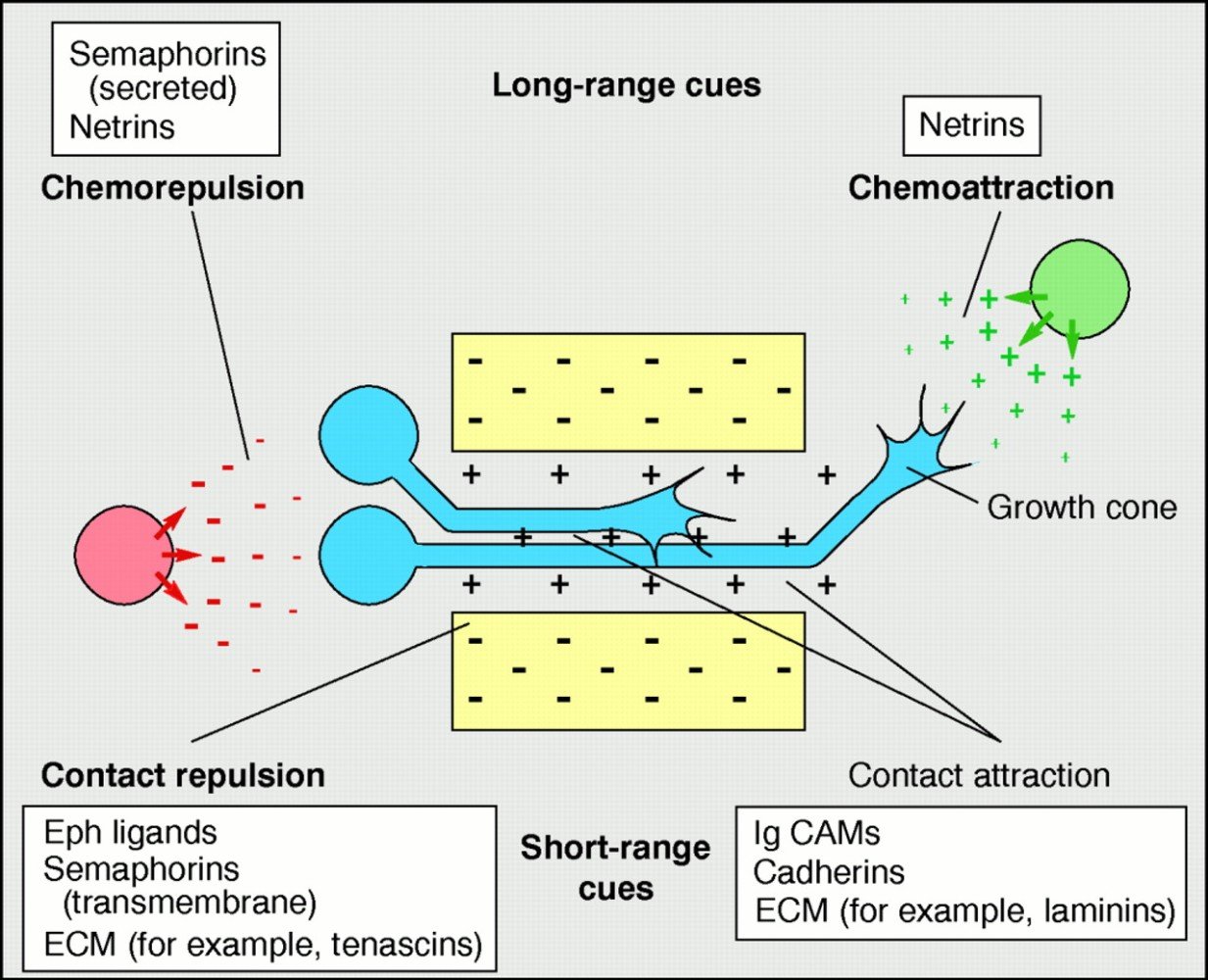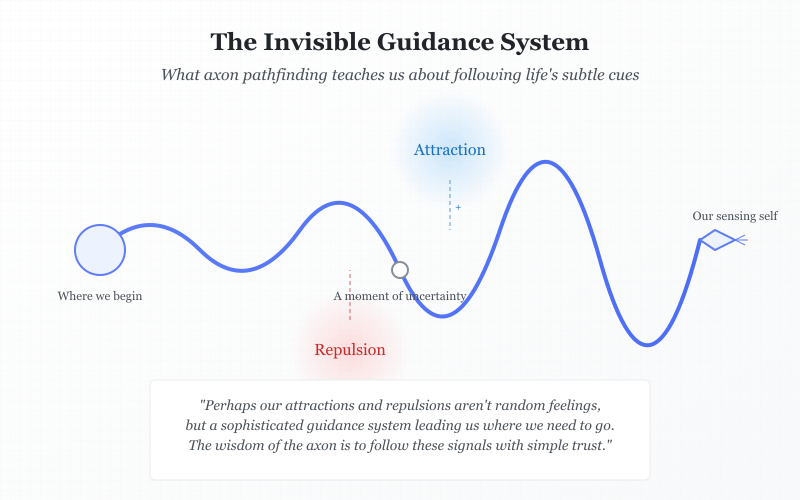It was winter 2024. I was a few months into my PhD at the National Brain Research Centre, Gurgaon, still finding my footing in the academic world.
Between long hours in the course-work classes, lab rotations and evenings spent poring over research papers, I found moments of unexpected clarity in the most ordinary places—like that particular day in our Neurodevelopment class. As Sourav Banerjee Sir advanced through his slides on axon pathfinding, what began as a scientific lecture quietly transformed into a profound life philosophy.
Every neuron in your brain—all 86 billion of them—had to find its correct destination during brain development. Each neuron’s target isn’t random but predetermined through an elegant combination of genetic programming and molecular matching systems. Neurons are born with specific molecular “identities” based on their lineage and position, which influence what guidance receptors they express. Many neurons and their targets even have complementary molecules that function like a lock-and-key system, ensuring they connect with remarkable precision.
The journey begins when a neuron extends a slender projection called an axon, which can grow to be thousands of times longer than the cell body itself. At the tip of this growing axon is a structure called the “growth cone”—a sensing apparatus that guides the axon toward its target.
What fascinates me most is how this navigation happens. Despite having a predetermined destination, the growth cone doesn’t “know” its final target in the way we might think. Rather than having a complete map, it employs sequential decision-making, making simpler choices at each junction. It responds to molecular cues in its environment—some that attract it and others that repel it. These guidance molecules create concentration gradients and contact points that the growth cone can detect and respond to as it moves through the developing brain.
Some molecules say “come this way” (attractants like netrins and neurotrophins), while others say “not here” (repellents like semaphorins and ephrins). By following these signals at each decision point, the axon eventually reaches exactly where it needs to go, sometimes traveling incredible distances with remarkable precision.

From Neural Pathways to Life Pathways
As I watched the animation of an axon navigating through brain tissue, following these molecular signposts, something resonated deeply within me. Beyond the biochemistry and cellular mechanics, I glimpsed a metaphor that spoke to human experience.
Isn’t this precisely how we move through life?

We rarely see our complete path ahead. At each junction, we sense what draws us forward and what warns us away. Those inexplicable attractions toward certain people, activities, or opportunities. Those intuitive repulsions from others. What if these aren’t random feelings but our personal guidance system?
The growth cone doesn’t question whether it should follow the netrin gradient—it simply responds. Yet how often do we second-guess our natural attractions: “I’m drawn to this path, but it seems impractical” or “I feel pulled toward this opportunity, but I can’t explain why.”
Of course, human decision-making is vastly more complex than axonal guidance. Where growth cones follow genetically programmed responses to molecular cues, we layer conscious deliberation, cultural influences, and learned behaviors onto our intuitive responses. Yet perhaps beneath these complexities, there remains a wisdom to our natural attractions and repulsions.
Not Destinations, But Directions
What struck me most was this realization: the attractants guiding an axon aren’t its ultimate destination—they’re directional signals. The netrin molecule isn’t the axon’s purpose; it’s merely guiding it toward something else.
Similarly, perhaps the things that attract us in life aren’t always ends in themselves but waypoints guiding us toward our true path. That book that inexplicably catches your interest, that field of study that won’t leave your thoughts, that person you feel compelled to know—these attractions might be life’s version of guidance molecules.
This isn’t to suggest a purely deterministic view where we’re simply following a predetermined path. Rather, it’s about recognizing that our attractions and aversions might contain meaningful information, even when we don’t fully understand them.
Trusting the Process
When growth cones reach critical decision points, they do something fascinating. They pause and become more complex, extending their finger-like filopodia to thoroughly sample the environment before committing to a direction.
Perhaps our own periods of uncertainty aren’t failures but necessary navigation. Maybe confusion is just our internal growth cone sampling the environment before finding its way forward. Those times when we feel stuck or unclear might be essential moments of gathering information before the next step reveals itself.
The Balance of Destiny and Choice
What I find most powerful about this parallel is how it honors both inherent tendencies and active choice. The neuron has a predetermined identity that influences which signals it can detect, yet it actively interprets these signals at each step.
Our lives might operate with a similar interplay—there may be inherent directions to our development shaped by our unique makeup, but how we respond to life’s signals involves our conscious participation. Unlike axons, we can reflect on our attractions and repulsions, question them, and even choose contrary to them when appropriate. This capacity for reflection adds a dimension to human navigation that axons don’t possess.
It’s also worth acknowledging that not all attractions lead to growth. Just as certain guidance molecules can be disrupted in development leading to navigational errors, our own attractions can sometimes arise from wounding or conditioning rather than authentic guidance. Discernment remains essential—intuition and rational reflection working as partners.
Living with Axonal Wisdom
It’s taken me until now, May 2025, to finally articulate this insight that has quietly guided me for the past year and a half. As I’ve reflected on this parallel between axonal guidance and human navigation, I’ve distilled a few principles that might help us apply this wisdom:
1. Follow your attractions without overthinking them. The things that naturally draw your interest may be guiding you somewhere important, even if you can’t see the whole path yet.
2. Respect your repulsions. When something consistently feels wrong, perhaps it’s a guidance cue steering you away from a path not meant for you.
3. Be patient at choice points. Periods of uncertainty and exploration are not failures but necessary parts of navigation.
4. Trust the process. You may not know your ultimate destination, but you can trust each step that feels right.
5. Balance intuition with reflection. Unlike axons, we have the gift of consciousness to help us discern which attractions serve our growth and which might not.
Finding Our Way
What consistently attracts you that you’ve been dismissing? What repels you that you’ve been forcing yourself toward? What might happen if you began to trust these signals as information rather than noise?
The next time you find yourself drawn toward something that doesn’t seem to make “logical” sense, or feeling an inexplicable aversion to what seems like a reasonable path, remember the wisdom of the growth cone. These attractions and repulsions might be part of a sophisticated guidance system helping you navigate toward fulfillment.
Our inner compass may be more nuanced than we realize. Perhaps if we listened to it more carefully—following what attracts us and respecting what repels us—we might find ourselves, not where fate dictated, but where our authentic nature can fully flourish.
Like the axon that finds its destination not by seeing the entire path but by responding to each guidance cue along the way, perhaps our greatest wisdom lies in trusting the next step that resonates most deeply within us.
Continue the Journey with The Aiikyam Journal (TAJ)
If this reflection resonated with you, I invite you to join our community of boundary-crossing thinkers and renaissance minds in The Aiikyam Journal (TAJ).
In Hindi, “taj” means “crown”—symbolizing the adornment of the mind with diverse perspectives. Just as a crown brings together different jewels to create something greater than its parts, each edition of TAJ weaves together insights from philosophy, neuroscience, anthropology, psychology, literature, and lived experience.
Every Saturday at 7AM, TAJ arrives in your inbox with:
- Thoughtful Reflections that illuminate familiar ideas from fresh perspectives
- Questions Worth Sitting With that continue working in you long after reading
- Connections Across Disciplines revealing how seemingly separate domains inform each other
- Contemplative Practices bridging understanding and daily living
- Curated Discoveries from the rich landscape of human inquiry
This isn’t another information burden—it’s a space where ideas breathe, connections reveal themselves, and questions are valued as much as conclusions.
Join The Aiikyam Journal and let’s navigate life’s profound questions together.
